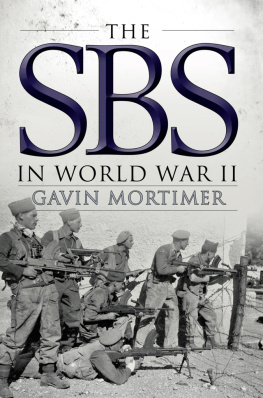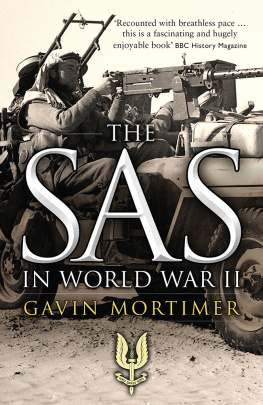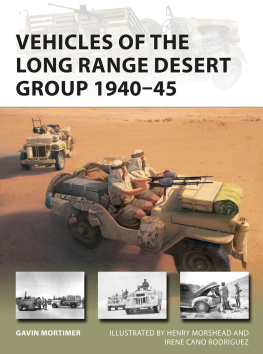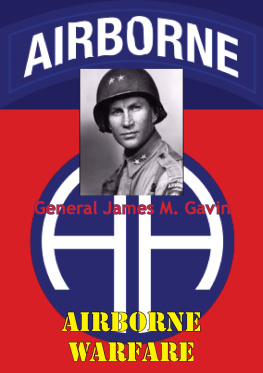Gavin Mortimer - The SBS in World War II: An Illustrated History by Gavin Mortimer (General Military)
Here you can read online Gavin Mortimer - The SBS in World War II: An Illustrated History by Gavin Mortimer (General Military) full text of the book (entire story) in english for free. Download pdf and epub, get meaning, cover and reviews about this ebook. year: 2016, publisher: Osprey Publishing, genre: Non-fiction. Description of the work, (preface) as well as reviews are available. Best literature library LitArk.com created for fans of good reading and offers a wide selection of genres:
Romance novel
Science fiction
Adventure
Detective
Science
History
Home and family
Prose
Art
Politics
Computer
Non-fiction
Religion
Business
Children
Humor
Choose a favorite category and find really read worthwhile books. Enjoy immersion in the world of imagination, feel the emotions of the characters or learn something new for yourself, make an fascinating discovery.
- Book:The SBS in World War II: An Illustrated History by Gavin Mortimer (General Military)
- Author:
- Publisher:Osprey Publishing
- Genre:
- Year:2016
- Rating:4 / 5
- Favourites:Add to favourites
- Your mark:
- 80
- 1
- 2
- 3
- 4
- 5
The SBS in World War II: An Illustrated History by Gavin Mortimer (General Military): summary, description and annotation
We offer to read an annotation, description, summary or preface (depends on what the author of the book "The SBS in World War II: An Illustrated History by Gavin Mortimer (General Military)" wrote himself). If you haven't found the necessary information about the book — write in the comments, we will try to find it.
The SBS in World War II: An Illustrated History by Gavin Mortimer (General Military) — read online for free the complete book (whole text) full work
Below is the text of the book, divided by pages. System saving the place of the last page read, allows you to conveniently read the book "The SBS in World War II: An Illustrated History by Gavin Mortimer (General Military)" online for free, without having to search again every time where you left off. Put a bookmark, and you can go to the page where you finished reading at any time.
Font size:
Interval:
Bookmark:

DEDICATION
For the men of the Alimnia Patrol, and for their mothers, who went to their graves without knowing the truth.
ACKNOWLEDGEMENTS
In researching a book such as this, the many hours that one spends in archives are made all the easier by the efficiency of the staff. In the case of this book I could not have wished for more amiable assistance. I am therefore indebted to all the staff at the National Archives in Kew; the London Metropolitan Archives; the Imperial War Museum; and the Wiener Library, a charming archive in Russell Square focusing on contemporary Jewish history. I am particularly grateful to all at the SAS Regimental Association who once again allowed me to rummage through their extensive archive.
Thank you to the Board of Deputies of British Jews for granting me permission to view the Report on British Servicemen captured in Greece in 1944 housed in the Metropolitan Archives, and I tip my hat once again to John Robertson, whose exhaustive research has resulted in the superb website www.specialforcesroh.com.
As ever Emily Holmes and all the team at Osprey have been accommodating and patient, indulging my whims and editing with precision. Thank you.
And thanks to the following publishers who gave me permission to quote from their titles: Going to the Wars by John Verney (Collins, 1955), Anders Lassens War by Thomas Harder (Informations Forlag, 2010), Anders Lassen by Mike Langley (New English, 1988), The Filibusters by John Lodwick (Metheun, 1947) and the Imperial War Museum Collections Department.
Although, regrettably, the number of veterans from World War II is a dwindling band, the relatives of combatants continue to honour the memory of those who served. In the writing of this book I received great help and support from Lynne Perrin (daughter of Duggie Pomford), Angie English and Raymond Duggan (daughter and son of John Duggan), Holly Kendrick (niece of George Evans), Paul Ogden (nephew of Tom Kitchingman), David Henry (grandson of Jack Emerton), Ian Layzell (son of Albert Layzell) and Jane Waterman (daughter of John Waterman).
Finally I would like to thank Dick Holmes, John Waterman and Reg Osborn for giving me so much of their time and delving so deep into their memory to relive events of so long ago. It was a privilege and I hope this book honours those who never returned.
INTRODUCTION
In September 1942 General McCreery, chief of staff to General Harold Alexander, Commander-in-Chief Middle East Command, wrote to his superior about a small special forces unit operating in North Africa. It had been a conspicuous success in the past, wrote McCreery, and its morale is high. He then added:
For a detailed account of this unit read Gavin Mortimer, The SAS in World War II (Osprey, 2015).
The personality of the present commander, L Detachment SAS [Special Air Service] Brigade, is such that he could be given command of the whole force with appropriate rank. In view of this I make the following suggestion. That L Detachment SAS Brigade, 1 SS [Special Service] Regiment, Special Boat Section should all be amalgamated under L Detachment SAS Brigade and commanded by Major D. Stirling with the rank of lieutenant-colonel.
Alexander accepted the recommendation and on 28 September 1942 General Headquarters Middle East Forces issued an order promoting the 26-year-old David Stirling and authorising him to expand his unit into a regiment.
Stirling envisaged the SAS regiment comprising five squadrons A, B, C, D and HQ and he set its war establishment at 29 officers and 572 other ranks. His most pressing challenge was to fill his nascent regiment with suitable soldiers, while assisting in the Eighth Armys imminent offensive against Axis forces at El Alamein. Stirling formed his most experienced men, the bulk of L Detachment, into A Squadron under the command of the formidable Blair Paddy Mayne, and instructed them to attack targets along the coast between Tobruk and the rear of the enemy front line. While A Squadron headed into the desert to harass the Germans, Stirling returned to the SAS base at Kabrit, 90 miles east of Cairo, to continue recruiting and to oversee the training of the new soldiers.
It was a confused period, both for the SAS then and for historians now, endeavouring to unravel the administrative knots that Stirling unintentionally tied through his abhorrence of paperwork. The only time Stirling committed anything to paper was shortly after the war when, in a brief typewritten history of the regiment now housed in the SAS archives, he listed the units under his command in January 1943, the month he was captured by the Germans:
a) 1st SAS Regiment. L Detachment had become the 1st SAS Regiment in October 1942. Its establishment consisted of five squadrons a total of about 50 officers and 450 OR [other ranks]. At the time of my capture the full strength had not yet been recruited. I had about 40 officers and 350 OR but was hoping to make the full strength from the Middle East Commando, which I had taken over and was sorting.
b) The French SAS Squadron. This unit had been considerably added [sic] and in January 1943 consisted of about 14 officers and 80 OR. I hoped that this unit would form the nucleus of a French SAS Regiment, which I reckoned would be able to carry out useful operations in France preceding and during the inevitable 2nd Front in Europe.
c) The Greek Sacred Squadron. I had taken over this unit towards the end of 1942 and had not finally completed their training at the time of my capture. My idea was to use the Greek Sacred Squadron for raiding operations in the Eastern Mediterranean, where their local knowledge would be of great value. The unit consisted of 14 officers and about 100 OR.
d) Folboat Section [Special Boat Section]. This unit had had a separate existence up until August 1942 and had carried out many brilliant operations. My intention was to absorb them into the 1st SAS Regiment as a squadron but I was in the meantime giving them the full SAS training, including a parachute course. They had about 15 officers and about 40 OR.
e) Captain Bucks German Unit. Due to casualties and difficulties of recruitment, this unit had unfortunately ceased to exist. f) Middle East Commando. I took command of the Middle East Commando about November 1942. Although of good material, the unit had been given very little opportunity and in my view were badly commanded. When I took over it consisted of about 30 officers and 300 OR, which I intended to disband all bar 10 officers and 100 OR, which would bring the 1st SAS Regt up to strength.
Stirling was captured on 24 January 1943 in Tunisia as he attempted to link up with the advance elements of the First Army advancing east from Algeria. The news was confirmed in the SAS war diary on 14 February, the entry stating that Stirling was officially missing believed prisoner of war.
The news was a crushing blow to the young regiment. The SAS medical officer, Malcolm Pleydell, wrote to a friend in
The ship was without a rudder, or a leader, and for several weeks the SAS drifted. Stirlings nominal successor, Paddy Mayne, loathed bureaucracy even more than his superior and the burden of trying to make sense of what paperwork there was at Kabrit fell on the regiments adjutant, Captain Bill Blyth, who sat glumly at his desk piled high with files.
But even if Stirling had not been captured the future role of the SAS was being discussed in Middle East Headquarters. The Desert War was nearly won and there was no longer a need for the sort of hit-and-run raids in which the SAS specialized. The Axis forces were on the retreat and would soon be pushed out of North Africa altogether.
Next pageFont size:
Interval:
Bookmark:
Similar books «The SBS in World War II: An Illustrated History by Gavin Mortimer (General Military)»
Look at similar books to The SBS in World War II: An Illustrated History by Gavin Mortimer (General Military). We have selected literature similar in name and meaning in the hope of providing readers with more options to find new, interesting, not yet read works.
Discussion, reviews of the book The SBS in World War II: An Illustrated History by Gavin Mortimer (General Military) and just readers' own opinions. Leave your comments, write what you think about the work, its meaning or the main characters. Specify what exactly you liked and what you didn't like, and why you think so.









